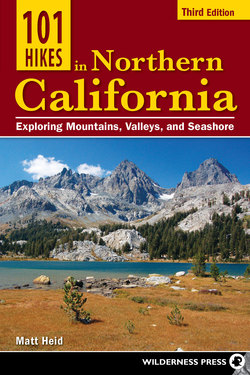Читать книгу 101 Hikes in Northern California - Matt Heid - Страница 29
На сайте Литреса книга снята с продажи.
ОглавлениеHIKE 12 Coyote Hills
Highlight Shorebird paradise
Distance 2.5 miles
Total Elevation Gain/Loss 400'/400'
Hiking Time 1–2 hours
Recommended Maps Coyote Hills Regional Park by East Bay Regional Park District, USGS 7.5-min. San Leandro
Best Times December–May
Agency Coyote Hills Regional Park, East Bay Regional Park District
Difficulty
A GRASSY SWELL IN the flatlands, Coyote Hills exists almost in the center of south San Francisco Bay. Protected marshlands enhance the unique perspective and offer a rich assortment of wildlife.
For thousands of years, the Ohlone Indians occupied the region around Coyote Hills, harvesting oysters, clams, mussels, cockles, and abalone from the extensive Bay mudflats; salmon, seals, seal lions, sea otters, and sturgeon from the water; and deer, elk, antelope, and rabbit from the surrounding hills. Using tule reeds from the vast marshlands, they constructed small boats for paddling in the bay. We know all this because four substantial middens still exist in Coyote Hills Regional Park. Middens—also referred to as shell mounds—are large piles of accumulated debris, the “kitchen wastes” of the Ohlone. Shells, bones, trinkets, and other discarded materials forming these large piles have shed a great deal of light on the Ohlone lifestyle.
With the arrival of the Spanish, it all came to an end. Disease and the mission system decimated the Indian population, and by the 19th century, salt evaporation ponds and ranch lands began to surround Coyote Hills, all but eliminating the vast marshlands. Having passed through various owners, the ranch land that included Coyote Hills and a large remaining segment of marsh was purchased by the East Bay Regional Park District in 1967. Today it provides an excellent opportunity to imagine the bay as it was before the Europeans came.
Wildlife still abounds in this ecological oasis. At least 210 species of birds have been spotted in the park, including a variety of herons, egrets, owls, pheasants, hawks, and shorebirds. More than 30 different mammals also exist in the park, mostly small rodents hunted by foxes, weasels, and raptors.
The Hike connects several short segments of trail to form a loop, passing first along the marsh before returning via Red Hill (291'). Expansive hilltop views can only be enjoyed immediately after a winter storm has cleansed the thick South Bay air; move fast—air quality begins to deteriorate within 24 hours. The hills are velvety green from January through May, turning brown in summer and fall when the skies fill with haze. Water is available at the trailhead.
To Reach the Trailhead Take Hwy. 84 to the east side of the Dumbarton Bridge and exit at Paseo Padre Pkwy. Head north on Paseo Padre for 1 mile and turn left onto Patterson Ranch Rd., following it for 1.5 miles to the visitor center at road’s end. There is a $5 entrance fee per vehicle. The park opens at 8 a.m. and closes at sunset.
Description From the visitor center parking lot, go through the gate and take the paved Bayview Trail, skirting the edge of the marsh partly shaded by small willow and sycamore trees. A chittering of birds and croaking of frogs keep you company. The trail passes a few Monterey pines before reaching the junction for Lizard Rock Trail at the far end of the marsh—go right toward the red rock outcrop. This outcrop is Franciscan chert, formed from the silica-rich skeletons of microscopic sea creatures that collected on the ocean floor over millions of years. All of Coyote Hills is composed of this chert, which gains its red color from trace amounts of iron. Highly resistant to erosion, chert has withstood the elements while the surrounding area eroded and became covered with thick layers of mud and silt washed down from the hills. In a sea of mud, Coyote Hills is an isolated island of bedrock.
Stay by the marsh and loop east around the small hill before returning to Bayview Trail, passing a many-branched coast live oak along the way. Continuing on the paved path, you soon reach a junction where another paved trail splits right for the Alameda Creek Trail. Here you go left up dirt Red Hill Trail, climbing steeply to the top of the first hill before dropping down to a junction with Nike Trail, named for the Nike missile site that was situated on these hills between 1955 and 1959 to protect the United States from Communist invasion. Continuing straight, the trail ascends Red Hill, high point of the park, where your best views are had. Descending Red Hill, return to the visitor center by bearing left on Soaproot Trail and left again on wide Quail Trail.
Nearest Visitor Center Coyote Hills Visitor Center, 510-544-3220, is open Wednesday–Sunday 10 a.m.–4 p.m.
Additional Information ebparks.org/parks/coyote_hills
